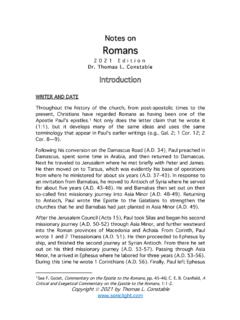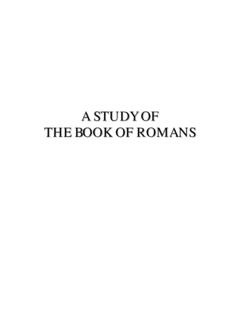Transcription of A Short History of Spain and Portugal - Stanford University
1 A Short History of Spain and Portugal chapter 1. The Iberian Peninsula in pre-Roman Times : Iberians : Celts : Carthaginians. 3. chapter 2. Roman Hispania and Lucitania. 5. chapter 3. The Visigoths - 5th to 7th Centuries. 6. chapter 4. The Moors - 8th to 11th Centuries. 8. chapter 5. The Reconquista - 8th to 15th Centuries. 10. chapter 6. The Rise of Portugal : The East Indies. 13. chapter 7. The Western Voyages of Exploration. 16. chapter 8. Colonisation of America in the 16th Century. 17. chapter 9. Spain 's Golden Age (the 16th Century) : The Union with Portugal . 19. chapter 10. The Decline of Spain : Portugal Recovers her Independence. 22. chapter 11. The War of the Spanish Succession (1701-1724). 24. chapter 12. The 18th Century. 26. chapter 13. The Napoleonic Period : The Peninsular War. 28. chapter 14. Spanish and Portuguese America in the 17th and 18th Centuries.
2 30. chapter 15. The Loss of the American Colonies. 32. chapter 16. A Hundred Years of Strife in Spain , 1833-1236. 34. chapter 17. A Hundred Years of Strife in Portugal , 1826-1926. 37. chapter 18. The Spanish Civil War, 1936-39. 38. chapter 19. Spain under General Franco (1939-1975). 39. chapter 20. Portugal under Salazar (1932-1968) and After. 42. Appendix 1. Some Population Statistics. 44. Appendix 2. Rulers of Spain from 1479. 47. Appendix 3. Rulers of Portugal . 48. Appendix 4. Andorra. 49. Maps: Spain and Portugal to the 19th Century (Chapters 1-13) 50. Maps: Spain and Portugal (Modern) 51. Foreword Episodes in which Spain and Portugal have been deeply involved with other countries - for instance the Netherlands., Italy, Morocco, the East lndies - but which are more importantly part of the histories of those countries, are only briefly summarised in this History .
3 Exceptionally, a rather longer summary is given of the Spanish and Portuguese colonisation in America - though that is more fully covered in A Short History of Latin America . A brief History of Andorra is included as an appendix. This Short History has been compiled from the study of a number of works, including 's History of Europe , 's Encyclopaedia of World History , and the Encyclopaedia Britannica. chapter 1. - The Iberian Peninsula in pre-Roman Times : Iberians : Celts : Carthaginians. In pre-historic times parts of the Iberian Peninsula (modern Spain and Portugal ) were occupied by Stone Age inhabitants whose legacies to posterity are remarkable cave paintings of animals. The most notable surviving example of their art is in the cave paintings of Altamira (west of Santander in northern Spain ). Around 3000 tribes of dark-skinned Iberians from Africa began to settle in the peninsula - hence the name Iberia.
4 A long time later - after 1000 - successive waves of Celtic tribes infiltrated across the Pyrenees. By about 600-400 the Celts dominated northern Spain and Portugal , and then spread throughout the peninsula, ruling and mixing with the Iberians to form the "Celtiberian" culture. During the same period, from about 900 onwards, peoples from the eastern Mediterranean came to Iberia in search of trade, mainly interested in the mineral wealth of the country - silver, iron and copper. The first to come were the Phoenicians, who brought with then the technique of writing. Their most important settlement was Gadir (modern Cadiz). They were followed, from about the 7th century , by Greek traders and colonists. The Greeks introduced the vine and the olive into Spain . Their main trading post was Ampurias, in Catalonia. In the 6th century the Phoenicians of Gadir called in their compatriots from the Phoenician colony of Carthage in North Africa to help repel attacks by the native tribes.
5 The Carthaginians stayed on in the peninsula, which they called Span or Spania, meaning "land of rabbits". At first they confined them-selves to trade and the exploitation of the silver mines; but later they saw in Spain , with its tough tribesmen whom they engaged as mercenaries, a source of power and a base for operations against their great rival, Rome. After the defeat of Carthage in the First Punic War with Rome (264-241 ) the Carthaginian general Hamilcar Barca built up in Spain a powerful state and formidable army.* His son-in-law and successor, Hasdrubal, founded a capital city New Carthage (Cartagena) and continued Hamilcar's work. Rome, apprehensive of this growth of Carthaginian strength in Spain , concluded a treaty with Hasdrubal under which the Carthaginians were to remain south of the Ebro and were not to molest Saguntum, an independent town (originally settled by Greek colonists) south of the river, friendly to Rome.
6 Hasdrubal was assassinated in 22:L , and was succeeded as Carthaginian Commander-in-chief in Spain by Hannibal, the 26 year old son of Hamilcar, and greatest of the Barca family. To pick a quarrel with Rose Hannibal attacked Saguntum in 219 (capturing it after an eight months siege) and started the Second Punic War with Rome (218-201 ). The Carthaginians under Hannibal marched through southern Gaul and crossed the Alps into Italy. Here, Hannibal campaigned successfully for fourteen years, but was unable to capture Rome. Meanwhile the Roman general Scipio evicted the Carthaginians from Spain , and after Hannibal had been recalled to Carthage he was defeated by Scipio at the decisive Battle of Zama in 202 Carthage gave up her overseas possessions, and in Iberia the Romans set about the subjugation of the fiercely independent Celtiberian tribes.
7 The early Phoenicians, the Greeks, and the Carthaginians had made no lasting impression on the peoples of the Iberian Peninsula. One of these peoples, who deserve separate mention, is the Basques. They inhabited, and still do inhabit, the mountainous area (mainly in Spain but partly in France) in the angle of the Bay of Biscay. Their origin, and that of their unique language unrelated to any other - is uncertain and the subject of scholarly dispute. Perhaps they are a remnant of the Celtiberians, or even of the earlier Stone Age inhabitants of the western Pyrenees. Throughout the ages they have succeeded in preserving some privileges of local self- government, and their language, though most of them now speak Spanish or French as well. * Barcelona, founded in the 3rd century , is thought to have been named after Hamilcar Barca.
8 chapter 2. - Roman Hispania and Lusitania. Rome divided Spain into two provinces: Hispania Citerior (Hither Spain ) in the north, Hispania Ulterior (Farther Spain ) in the south, and later formed the province of Lusitania in the west, corresponding roughly with modern Portugal . But it took the Romans a hundred years to overcome all major areas of resistance, and a further hundred years to subdue the whole peninsula. The Lusitanian's for long resisted stubbornly led by the heroic Viriatus, around 140 they temporarily regained a lot of territory from the Romans. Equally heroic was the defence of the city of Numantia in northern Spain . Besieged for some twenty years until the city fell in 133 , the Numantians were nearly all killed or committed suicide, and the city was totally destroyed. With the peninsula finally subjugated, the Roman peace" lasted throughout the early centuries They were centuries of law and order, efficient administration, expanding production olive oil, wheat, wine, honey - and prosperous trade.
9 Roman roads facilitated communication - the Via Augusta stretched from Cadiz to the Pyrenees. Latin became the official language, from which modern Spanish and Portuguese were derived. Large Roman cities grew up, which were centres of government, of trade, and of cultural activity. The native peoples were gradually allowed to become full Roman citizens. Roman Spain contributed to the Roman Empire many famous men: the writers Seneca, Lucan, Quintilian and Martial, all in the first century , and the Emperors Trajan, Nadrian and Marous Aurelius in the second century and Theodosius the Great in the fourth. When Rome officially adopted Christianity early in the 4th century, Romanised Spain and Portugal readily followed suit. chapter 3. - The Visigoths - 5th to 7th Centuries. The 3rd century was a period of domestic strife in Rome and of declining Roman power; and the German tribes of the north, previously held at bay, began to encroach an the Empire.
10 In the middle of the century the Visigoths (or Western Goths) occupied Roman Transylvania, and from then onwards carried out large-scale raids into the eastern provinces of the Empire. Then, in the middle of the 4th century, the Mongolian Huns from Asia pressed westwards and evicted the Visigoths, who sought protection from Rome. They were allowed to cross the Danube; and after disputes which led to war with Rome - sad victory for the Visigoths - they settled in what is now Bulgaria. Their army became nominally a Roman army. The Empire had now split into eastern and western halves; and Alaris the Visigoth made a puppet of the eastern Empire. He did not seek to destroy the Roman Expire, but to obtain for himself and his people - who were becoming "Romanised' and had adopted the Arian version of Christianity - a prominent position in it.













